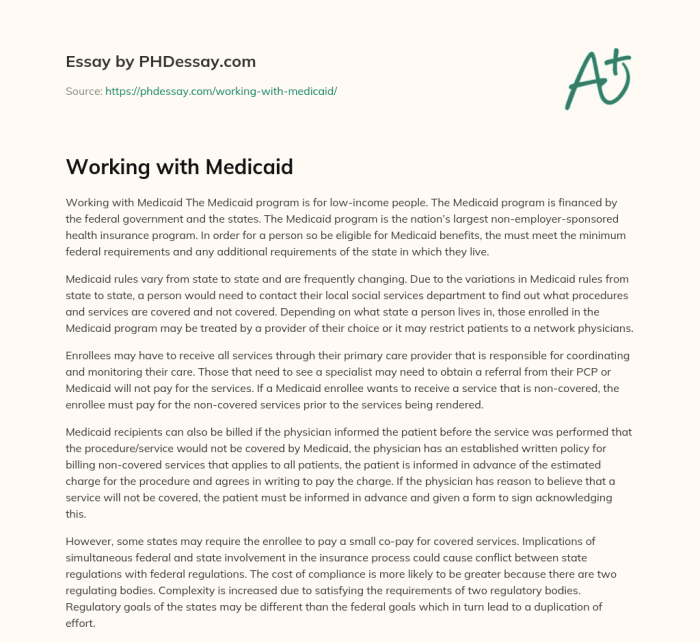
Medicaid work requirements disability essay explores the complex implications of work mandates for disabled Medicaid recipients. This essay delves into the historical context of these requirements, examining the evolving policies and their potential impact on vulnerable populations. The analysis will cover the varied state regulations, potential negative consequences for disabled individuals, and the broader societal implications of these policies.
The essay will analyze the potential negative impacts on healthcare access, affordability, and financial stability for individuals with disabilities and their families. It will also consider the legal challenges, alternative approaches, and international comparisons to provide a comprehensive understanding of the issue. The aim is to critically evaluate the effectiveness and fairness of these requirements, ultimately providing insights into potential solutions that balance work incentives with the specific needs of disabled individuals.
Introduction to Medicaid Work Requirements
Medicaid, a crucial government program providing healthcare coverage to low-income individuals and families, has seen the introduction of work requirements in many US states. These requirements aim to encourage recipients to participate in the workforce and reduce reliance on public assistance. However, the implementation and impact of these requirements have been highly debated, with arguments revolving around their effectiveness in achieving workforce participation and their potential to exacerbate existing inequalities.
This section delves into the historical context, different types, and variations of these work requirements across states.The concept of work requirements in Medicaid programs emerged as part of broader efforts to reform welfare programs. These efforts often focused on encouraging recipients to become self-sufficient through employment. The evolution of these requirements reflects ongoing debates about the role of government assistance, the effectiveness of work incentives, and the needs of vulnerable populations.
These debates are constantly evolving as new research emerges and as socioeconomic conditions change.
Historical Context and Evolution
The origins of Medicaid work requirements can be traced back to the 1996 Personal Responsibility and Work Opportunity Act. This legislation, along with subsequent policy changes, fostered a trend toward incorporating work requirements into welfare programs. Medicaid, as a crucial safety net, began to reflect these changes. Over time, more states implemented work requirements, often as part of larger reform initiatives aimed at promoting self-sufficiency and reducing the financial burden on the government.
The implementation of these requirements, however, has been highly variable across states, reflecting differing approaches to welfare reform.
Types of Work Requirements
States imposing Medicaid work requirements vary significantly in the types of work they demand. Some states may mandate a minimum number of hours worked per week. Others might require participation in job training programs or adherence to specific employment goals. There are notable differences in the requirements imposed, reflecting varying approaches to incentivizing work participation and aligning with differing state-level priorities.
Comparison of State Requirements
| State | Hours Worked | Type of Work | Exemptions |
|---|---|---|---|
| State A | 20 hours/week | Any employment | Disability, childcare responsibilities, education |
| State B | 15 hours/week | Work in a specified industry | Disability, pregnancy, caregiving responsibilities |
| State C | 10 hours/week | Work in a designated sector | Disability, serious illness, school attendance |
| State D | Variable (based on individual circumstances) | Any employment | Disability, pregnancy, lack of transportation |
The table above illustrates the varied approaches states have taken in implementing work requirements for Medicaid recipients. Significant disparities exist in the hours required, types of employment considered, and the exemptions available to individuals. The data represents a snapshot in time, and requirements are subject to change. Furthermore, the table does not account for potential variations within specific state requirements.
Impact on Disability Recipients
Medicaid work requirements, while intended to encourage employment, can have significant and often detrimental consequences for individuals with disabilities. These requirements frequently overlook the unique challenges faced by people with disabilities, leading to potential harm and exacerbating existing inequalities. The implementation of such requirements needs careful consideration of the specific needs and circumstances of this vulnerable population.The impacts of work requirements on disability recipients are multifaceted and can extend far beyond simply the loss of Medicaid coverage.
They affect healthcare access, financial stability, and overall well-being. Many disabled individuals face significant barriers to employment, including physical limitations, cognitive impairments, and lack of accessible accommodations. Mandated work requirements, without adequate support systems, can increase the existing struggles and create new obstacles.
Potential Negative Impacts on Employment
The employment landscape is often challenging for individuals with disabilities. Discrimination and a lack of understanding about disabilities can lead to missed job opportunities. Physical limitations or cognitive impairments may make it difficult to perform certain tasks, even with accommodations. Furthermore, the lack of accessible transportation or necessary assistive technologies can prevent individuals from participating in the workforce.
Finding employment that accommodates a disability requires patience, resources, and often extensive efforts, which are often hampered by the requirements.
Disproportionate Impact on Vulnerable Populations
Individuals with disabilities from low-income backgrounds, racial minorities, and those with co-occurring mental health conditions are disproportionately affected by work requirements. These individuals often face a combination of systemic barriers, including limited access to resources, inadequate support services, and historical disadvantages. The additional burden of work requirements exacerbates these pre-existing challenges, potentially pushing them further into poverty and hindering their ability to improve their lives.
Impact on Healthcare Access and Affordability
Medicaid is a crucial source of healthcare coverage for many disabled individuals. The loss of Medicaid coverage due to work requirements can lead to a significant reduction in access to essential medical services. This can result in delayed or forgone medical care, leading to worsening health conditions and increased healthcare costs in the long run. Many individuals with disabilities require specialized medical care and therapies, and the loss of coverage can make it extremely difficult, if not impossible, to maintain their health.
Financial Implications for Families
The financial implications of work requirements on families with disabled members are substantial. Many families rely on Medicaid benefits to support their disabled members’ needs. The loss of these benefits can strain household budgets, potentially forcing families to make difficult choices regarding their disabled members’ care and well-being. Families might be forced to choose between paying for essential needs, like food and shelter, or paying for the care and services required by their disabled members.
The stress and uncertainty this creates are significant and can impact the overall quality of life for everyone involved.
Potential Barriers to Employment for Individuals with Disabilities
Many barriers to employment for individuals with disabilities stem from systemic issues and lack of access to necessary support services. These include a lack of accessible workplaces, inadequate transportation options, and a shortage of trained professionals to support individuals with disabilities in the workplace. The lack of understanding and accommodation from employers often creates a significant obstacle to entering and maintaining employment.
In addition, a lack of awareness among employers about the importance of disability accommodations can lead to a lack of opportunities for individuals with disabilities.
Legal and Policy Challenges

Medicaid work requirements, while intended to encourage work and reduce costs, have faced significant legal challenges. These challenges often center on the balance between incentivizing work and protecting the rights and needs of vulnerable populations, particularly those with disabilities. The legal landscape is constantly evolving, with ongoing litigation and shifting policy interpretations impacting the implementation and effectiveness of these requirements.The implementation of work requirements in Medicaid programs has raised concerns about potential discrimination and inequities, particularly for individuals with disabilities.
These concerns are often grounded in the complexities of disability, including variations in ability and support needs. A critical aspect of these legal and policy challenges is the interaction between work requirements and existing disability support programs.
Legal Challenges to Medicaid Work Requirements
Medicaid work requirements have been challenged in courts across the country on various grounds. These challenges frequently highlight potential violations of the Americans with Disabilities Act (ADA) and the Rehabilitation Act. Furthermore, challenges are often raised on the basis of the requirements’ potential to create undue hardship for individuals with disabilities.
Court Cases and Legal Arguments
Numerous court cases have addressed the constitutionality and legality of Medicaid work requirements. For example, cases have argued that the requirements disproportionately impact individuals with disabilities, potentially violating their rights under the ADA and Rehabilitation Act. The legal arguments frequently involve claims of undue burden, lack of individualized consideration, and the impact on access to essential services.
Relevant Legislation and Disability
Federal and state legislation plays a crucial role in defining the scope and implementation of Medicaid work requirements. Laws like the Affordable Care Act (ACA) have influenced the debate. The legislation also interacts with existing disability support programs, often creating inconsistencies and challenges for beneficiaries.
State Approaches to Implementation
States have adopted varying approaches in implementing Medicaid work requirements. Some states have more stringent requirements, while others have more flexible or individualized approaches. The varying approaches reflect differing interpretations of the law and differing priorities in the provision of healthcare and support services. This diversity often reflects the varied demographics and healthcare needs within each state.
Relationship to Disability Support Programs
Medicaid work requirements can have a complex relationship with existing disability support programs. In some cases, these requirements might create obstacles to accessing necessary services, leading to difficulties in employment and maintenance of independence. Conversely, some states have implemented programs to support the transition into employment, mitigating the negative impacts of these requirements. In addition, the availability of appropriate support services, such as job coaching and vocational training, plays a vital role in ensuring the successful participation of individuals with disabilities in work requirements programs.
Impact on Different Disability Groups
The impact of work requirements on different disability groups varies. For example, individuals with intellectual disabilities may face more significant challenges than those with mobility impairments. The varying levels of support needed and the specific types of disabilities require consideration in crafting policies and implementation strategies. Moreover, the impact of requirements on specific disability groups often reflects disparities in access to resources and support systems.
Alternative Approaches and Solutions
Navigating the complex terrain of work requirements for Medicaid recipients, particularly those with disabilities, demands innovative solutions that prioritize both economic self-sufficiency and individual well-being. Current approaches often fail to account for the unique challenges faced by people with disabilities, leading to unintended consequences and exacerbating existing inequalities. This section explores alternative strategies that can incentivize work while accommodating the diverse needs of this population.These alternative approaches must move beyond simplistic mandates and embrace a more nuanced understanding of disability.
They must focus on providing targeted support, tailored to the individual’s specific circumstances and abilities. This includes recognizing that the definition of “work” can extend beyond traditional employment, encompassing activities that contribute to the individual’s well-being and independence.
Potential Alternative Approaches
A crucial aspect of alternative approaches is recognizing the diversity of disabilities and the varying degrees of functional limitations. A one-size-fits-all approach is inadequate and often counterproductive. Instead, personalized support plans are essential.
- Customized Employment Support Services: Comprehensive support services tailored to individual needs, such as job coaching, vocational training, assistive technology provision, and transportation assistance, are paramount. These services can help individuals with disabilities navigate the complexities of the job market, enabling them to pursue employment opportunities that align with their abilities and goals. For example, a program might offer specialized training for individuals with learning disabilities in resume writing and interview skills, along with assistive technology like screen readers.
- Flexible Work Arrangements and Supported Employment: Providing options for flexible work schedules, part-time employment, and work-from-home opportunities can be crucial. Supported employment, where individuals with disabilities receive ongoing support and supervision in competitive employment settings, can lead to increased independence and integration into the community. This can involve on-the-job training, mentoring, and ongoing support from case managers.
- Focus on Independent Living and Community Integration: Supporting individuals with disabilities to live independently and actively participate in their communities can significantly impact their well-being and potential for employment. This might include accessible housing, transportation options, and community-based services that foster social interaction and independence.
Examples of Supportive Employment Programs
Effective programs should provide not just financial incentives, but also practical support to help individuals succeed in the workforce. These programs can include intensive job coaching, personalized training plans, and access to assistive technologies.
My latest read on the Medicaid work requirements for disability essay got me thinking about the humor in the world. It’s fascinating how Pope Francis uses social media, even creating engaging memes like those found on pope francis social media memes. It’s a stark contrast, yet perhaps not so surprising, when considering the social implications of the Medicaid work requirements for disability, which often seem to miss the mark in their approach to helping people.
- Supported Employment Programs: These programs pair individuals with disabilities with dedicated case managers and job coaches to assist in job searches, training, and ongoing support in the workplace. The focus is on finding competitive employment while ensuring the individual receives the necessary support to succeed.
- Vocational Rehabilitation Services: These services offer a wide range of support, from career counseling and skill development to job placement assistance and ongoing support in the workplace. They often work closely with individuals with disabilities to identify their strengths and interests, tailoring their approach to meet specific needs.
- Assistive Technology Services: Providing access to appropriate assistive technologies can dramatically improve an individual’s ability to perform tasks and participate in the workforce. This includes everything from adaptive equipment for daily living to software applications that can enhance communication and learning.
Comparative Analysis of Strategies
The effectiveness of different strategies for supporting disabled individuals in the workforce varies significantly depending on the individual’s specific needs and circumstances. A structured comparison can highlight the pros and cons of each approach.
Medicaid work requirements for disabled individuals are a complex issue, often debated in essays. Understanding how these policies impact the disabled population requires a nuanced perspective. This issue touches on a lot of different fields, including the rapidly evolving field of image recognition. Recent advancements in image recognition, like those in medical imaging, are providing valuable insights into how disabilities can be assessed and potentially affect the implementation of such requirements.
A deeper look at the definition of image recognition reveals how this technology can be applied to understand and assess the needs of individuals seeking Medicaid benefits. This understanding is crucial for the ongoing debate about Medicaid work requirements for disabled individuals.
| Strategy | Potential Benefits | Potential Drawbacks |
|---|---|---|
| Customized Employment Support Services | Tailored to individual needs, increased job retention, improved quality of life | Can be costly, requires skilled personnel, potential for administrative complexity |
| Flexible Work Arrangements | Increased work participation, reduced barriers to employment | May not be suitable for all types of work, potential for decreased earning potential |
| Supported Employment | Increased independence, competitive employment opportunities, community integration | Requires significant ongoing support, potential for limited job opportunities |
Balancing Work Requirements with Disability Needs
The key to successful integration lies in carefully balancing work requirements with the specific needs of individuals with disabilities. This requires a holistic approach that considers the unique circumstances of each individual. Policies should focus on supporting the development of skills and knowledge to help individuals gain employment. It’s crucial to provide the necessary accommodations and support services to ensure success.
“A well-designed support system can significantly improve the chances of employment and reduce the reliance on government assistance.”
Societal Implications

Medicaid work requirements, while intended to encourage employment, have significant societal ramifications that extend beyond individual recipients. Understanding these implications is crucial for a comprehensive evaluation of the policy’s effectiveness and fairness. These broader effects touch on economic stability, social welfare, and the very fabric of community support systems.
Impact on the Economy and Labor Force Participation Rates
The economic impact of work requirements for Medicaid recipients is multifaceted and not easily quantifiable. While proponents argue that participation in the workforce will boost overall economic productivity, potential downsides exist. The reduced access to Medicaid, and consequently healthcare, could lead to a decline in the health and productivity of the labor pool. This could negatively affect not only the recipients but also the businesses and industries employing them.
Furthermore, the shift in spending patterns from Medicaid to private healthcare might not necessarily translate into a commensurate increase in tax revenue or economic growth. The potential for increased healthcare costs for the general population, due to the rising number of uninsured individuals, is a concern that needs careful consideration.
Implications for Social Welfare and Support Systems
The societal implications of Medicaid work requirements extend to social welfare systems, potentially straining existing resources and support structures. Reduced access to Medicaid can lead to a decrease in the overall health of the population, which may impact the availability and cost of services within social support systems. For example, if recipients face difficulties in accessing medical care due to the work requirements, this could lead to an increase in emergency room visits and hospitalizations, ultimately placing a burden on the broader healthcare system.
This, in turn, could necessitate a reallocation of resources from other important social programs.
Potential Long-Term Consequences
The long-term consequences of Medicaid work requirements on disability recipients are complex and uncertain. There is a potential for a widening gap between those who can work and those who cannot, potentially exacerbating existing social inequalities. Moreover, the discouragement of participation in the labor market might lead to decreased self-esteem and reduced opportunities for personal growth, affecting overall well-being.
Examples of How Work Requirements Might Affect Community Resources and Support Services, Medicaid work requirements disability essay
The introduction of Medicaid work requirements could lead to a number of practical challenges for communities. For example, if individuals are unable to access healthcare, they might be more likely to experience chronic health conditions, which could require more frequent and intensive community-based support services. This could lead to an increase in demand for social workers, therapists, and other support personnel.
Moreover, if Medicaid recipients are unable to work due to their disability, the community might face a burden on local emergency services.
Case Studies and Examples
Medicaid work requirements have significantly impacted individuals with disabilities, often leading to unforeseen consequences and hardships. These requirements, while intended to encourage work participation, frequently fail to account for the unique challenges faced by people with disabilities. This section will present case studies that illustrate the real-world impact of these requirements.Understanding the experiences of individuals and families navigating these requirements is crucial to evaluating the effectiveness and fairness of such policies.
The examples below highlight the complexity and potential harm of Medicaid work requirements for those with disabilities, and serve as a crucial element in the broader discussion of policy reform.
Impact on Individuals with Specific Disabilities
Medicaid work requirements often impose substantial burdens on individuals with disabilities, particularly those with conditions that significantly limit their ability to work. The following table provides examples of such situations.
I’ve been tackling a Medicaid work requirements disability essay lately, and honestly, it’s been a real brain-buster. It’s fascinating how complex these issues can be, especially when you consider the human element involved. While I’m deep in the weeds of this essay, I’ve been finding some much-needed downtime with a great new Netflix watch, “One of Them Days” one of them days netflix watch.
Hopefully, this will help me approach the essay with a fresh perspective. I’m hoping to finish up this Medicaid work requirements disability essay soon, so I can move on to other projects!
| Individual’s Disability | State | Outcome |
|---|---|---|
| Multiple sclerosis, requiring significant physical assistance | State X | Loss of Medicaid coverage despite consistent efforts to find suitable employment; increased financial strain on the individual and family. |
| Intellectual disability, requiring intensive support services | State Y | Limited job opportunities and difficulty meeting work requirements; reduced access to necessary therapies and support services. |
| Chronic mental illness, experiencing relapses | State Z | Inability to consistently meet work requirements due to unpredictable health conditions; loss of Medicaid benefits and potential increase in homelessness or food insecurity. |
| Spinal cord injury, requiring wheelchair use and attendant care | State A | Difficulty finding suitable employment; limited options for accessible jobs; significant financial hardship resulting from loss of Medicaid coverage. |
Challenges Faced by Families with Disabled Members
The consequences of Medicaid work requirements extend beyond the individual, impacting entire families. Families often shoulder the burden of supporting disabled members, and these requirements can create a cascade of financial and emotional stress.
- Increased financial strain: Families may struggle to maintain their livelihood when a disabled member loses Medicaid coverage, which could lead to higher medical costs and other expenses, ultimately affecting the entire household’s well-being.
- Reduced access to essential services: The loss of Medicaid coverage can result in reduced access to crucial therapies, healthcare, and support services, negatively impacting the individual’s overall health and well-being.
- Emotional toll: The uncertainty and stress associated with navigating these requirements can place a significant emotional toll on both the disabled individual and their family members.
Navigating Medicaid Work Requirements
Successfully navigating Medicaid work requirements is a significant challenge for individuals with disabilities. Often, there is a lack of clear and accessible information, making it difficult to understand and comply with the requirements.
- Limited support systems: Individuals with disabilities may face limited access to support services, such as job training programs or vocational rehabilitation, making it harder to meet work requirements.
- Lack of accessible resources: Information regarding work requirements is not always readily available in accessible formats for individuals with disabilities, hindering their ability to understand and comply.
- Inadequate accommodations: Many employers may not be equipped to accommodate the needs of individuals with disabilities, making it challenging to find suitable employment.
International Comparisons: Medicaid Work Requirements Disability Essay
Looking beyond our borders offers valuable insights into the complexities of work requirements for Medicaid recipients, particularly those with disabilities. International experiences reveal a wide range of approaches to balancing workforce participation incentives with the unique needs of individuals with disabilities. Comparing these models can illuminate successful strategies and potential pitfalls of the American system.International approaches to supporting disabled individuals in the workforce often differ significantly from the American model.
These variations stem from differing cultural values, economic structures, and historical contexts. Understanding these contrasts is crucial for developing effective and inclusive policies.
Different Models of Support
International models vary considerably in their approaches to supporting disabled individuals in the workforce. Some countries emphasize comprehensive social safety nets, while others prioritize incentivizing employment. This diversity reflects a spectrum of societal priorities and resource allocation.
Successful Strategies for Integration
Several countries have demonstrated success in integrating work requirements with disability support. These models often include tailored support services for individuals with disabilities, such as job coaching, vocational training, and assistive technology. These interventions aim to reduce barriers and maximize employment opportunities.
Best Practices for Work Incentives
International best practices for integrating work requirements with disability support highlight the importance of individualized support. Programs in other countries frequently offer a range of support services, including job coaching, job placement assistance, and vocational training, tailored to the specific needs and abilities of each individual. This approach recognizes the diverse nature of disabilities and acknowledges the need for personalized interventions.
Furthermore, robust systems for monitoring and evaluating program effectiveness are critical for continuous improvement.
Lessons Learned from Diverse Approaches
Examining international experiences offers valuable lessons. Many countries with successful programs prioritize individualized support, ensuring that work requirements are adaptable to the specific needs of each disabled individual. This personalization avoids a one-size-fits-all approach, recognizing the unique challenges and strengths of individuals with various disabilities. Moreover, there’s a clear understanding that work participation is a spectrum, and success can take many forms.
Balancing Work Incentives and Disability Needs
A crucial element in international success stories is a careful balance between incentivizing work and providing adequate support for disability needs. Countries with well-established systems often offer a range of resources, such as subsidized employment programs, accessible workplaces, and financial assistance, to help disabled individuals transition into and maintain employment. These integrated support systems provide a comprehensive approach, acknowledging the multifaceted challenges faced by individuals with disabilities.
Examples of International Programs
- Germany utilizes a comprehensive social security system with strong emphasis on employment support services for people with disabilities. This includes subsidized employment programs and tailored vocational training.
- Canada‘s employment support programs for people with disabilities emphasize individualized support plans and access to resources like assistive technology. These initiatives are often integrated with social assistance programs.
- United Kingdom‘s approach to disability employment support emphasizes tailored support plans, vocational training, and access to assistive technology to help disabled people find and maintain employment.
These examples highlight the wide range of strategies used globally to support disabled individuals in the workforce. A key takeaway is the importance of a holistic approach that goes beyond simply imposing work requirements and encompasses comprehensive support services.
Final Conclusion
In conclusion, the Medicaid work requirements disability essay highlights the significant challenges and complexities surrounding these policies. The essay underscores the disproportionate impact on vulnerable populations and the potential for negative consequences on healthcare access, financial stability, and overall well-being. Alternative approaches and international comparisons offer valuable insights for creating policies that truly support disabled individuals while encouraging their participation in the workforce.
Ultimately, the essay advocates for a nuanced approach that recognizes the unique circumstances of individuals with disabilities and strives to create a system that balances work incentives with essential support.





